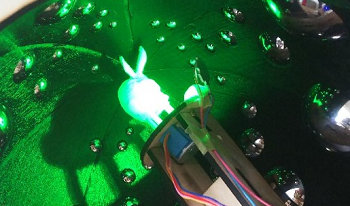References
1GortlerS. J.GrzeszczukR.SzeliskiR.CohenM. F.1996The lumigraphProc. 23rd Annual Conf. on Computer Graphics and Interactive Techniques, SIGGRAPH 1996435443–54ACMNew York, NY10.1145/237170.237200
2NgR.LevoyM.BredifM.DuvalG.HorowitzM.HanrahanP.
3AdelsonE. H.WangJ. Y. A.1992Single lens stereo with a plenoptic cameraIEEE Trans. Pattern Anal. Mach. Intell.149910699–10610.1109/34.121783
4JonesA.McDowallI.YamadaH.BolasM.DebevecP.2007Rendering for an interactive 360 light field displayProc. ACM SIGGRAPH Conf. on Computer Graphics1101–10ACMNew York, NY10.1145/1276377.1276427
5MukaigawaY.TagawaS.KimJ.RaskarR.MatsushitaY.YagiY.2011Hemispherical confocal imaging using turtleback reflectorLecture Notes in Computer Science (including subseries Lecture Notes in Artificial Intelligence and Lecture Notes in Bioinformatics)LNCS (PART 1) 6492Vol. 6492336349336–49SpringerBerlin, Heidelberg10.1007/978-3-642-19315-6_26
6YanoH.YendoT.2018Spherical full-parallax light-field display using ball of fly-eye mirrorACM SIGGRAPH 2018 Emerging Technologies, SIGGRAPH ’18ACMNew York, NY10.1145/3214907.3214917
7AdelsonE. H.BergenJ. R.1991The plenoptic function and the elements of early visionComputational Models of Visual Processing3203–20MITCambridge, MA
8LevoyM.HanrahanP.1996Light field renderingProc. 23rd Annual Conf. on Computer Graphics and Interactive Techniques, SIGGRAPH 1996314231–42ACMNew York, NY10.1145/237170.237199
9VaishV.WilburnB.JoshiN.LevoyM.2004Using plane + parallax for calibrating dense camera arraysProc. IEEE Computer Society Conf. on Computer Vision and Pattern RecognitionVol. 1IEEEPiscataway, NJ10.1109/CVPR.2004.1315006
10JonesA.BolasM.McDowallI.DebevecP.2006Concave surround optics for rapid multiview imagingACM SIGGRAPH 2006 Research Posters, SIGGRAPH 2006ACMNew York, NY10.1145/1179622.1179735
11MüllerG.BendelsG.KleinR.2005Rapid synchronous acquisition of geometry and appearance of cultural heritage artefactsVAST’052005132013–2010.2312/VAST/VAST05/013-020
12ChabertC. F.EinarssonP.JonesA.LamondB.MaW. C.SylwanS.HawkinsT.DebevecP.2006Relighting human locomotion with flowed reflectance fieldsACM SIGGRAPH 2006: Sketches, SIGGRAPH ’06ACMNew York, NY10.1145/1179849.1179944
13DebevecP.HawkinsT.TchouC.DuikerH. P.SarokinW.SagarM.2000Acquiring the reflectance field of a human faceProc. ACM SIGGRAPH Conf. on Computer Graphics145156145–56ACMNew York, NY10.1145/344779.344855
14IhrkeI.ReshetouskiI.ManakovA.TevsA.WandM.SeidelH. P.2012A kaleidoscopic approach to surround geometry and reflectance acquisitionIEEE Computer Society Conf. on Computer Vision and Pattern Recognition Workshops293629–36IEEEPiscataway, NJ10.1109/CVPRW.2012.6239347
15TaguchiY.AgrawalA.VeeraraghavanA.RamalingamS.RaskarR.2010Axial-cones: Modeling spherical catadioptric cameras for wide-angle light field renderingACM Trans. Graph.29181–810.1145/1882261.1866194
16UngerJ.WengerA.HawkinsT.GardnerA.DebevecP.2003Capturing and rendering with incident light fieldsEurographics Symp. on Rendering1101–10DTICFort Belvoir, VA
17LanmanD.CrispellD.WachsM.TaubinG.2006Spherical catadioptric arrays: Construction, multi-view geometry, and calibrationProc. – Third Int’l. Symp. on 3D Data Processing, Visualization, and Transmission, 3DPVT 2006818881–8IEEE Computer SocietyPiscataway, NJ10.1109/3DPVT.2006.130
18DingY.YuJ.SturmP.2009Multiperspective stereo matching and volumetric reconstructionProc. IEEE Int’l. Conf. on Computer Vision (ICCV)182718341827–34IEEEPiscataway, NJ10.1109/ICCV.2009.5459406
19KojimaY.SagawaR.EchigoT.YagiY.2005Calibration and performance evaluation of omnidirectional sensor with compound spherical mirrorsWorkshop on Omnidirectional Vision, Camera Networks and Non-classical Cameras (OMNIVIS’05)IEEEPiscataway, NJ
20ReshetouskiI.IhrkeI.2013Mirrors in computer graphics, computer vision and time-of-flight imagingLecture Notes in Computer Science (including subseries Lecture Notes in Artificial Intelligence and Lecture Notes in Bioinformatics)LNCS 82007710477–104SpringerCham
21LevoyM.ChenB.VaishV.HorowitzM.McDowallI.BolasM.2004Synthetic aperture confocal imagingACM SIGGRAPH 2004 Papers, SIGGRAPH 2004825834825–34ACMNew York, NY10.1145/1015706.1015806
22WangZ.BovikA. C.SheikhH. R.SimoncelliE. P.2004Image quality assessment: From error visibility to structural similarityIEEE Trans. Image Process.1310.1109/TIP.2003.819861
23SwaminathanR.2007Focus in catadioptric imaging systemsProc. IEEE Int’l. Conf. on Computer VisionIEEEPiscataway, NJ10.1109/ICCV.2007.4409205

 Find this author on Google Scholar
Find this author on Google Scholar Find this author on PubMed
Find this author on PubMed